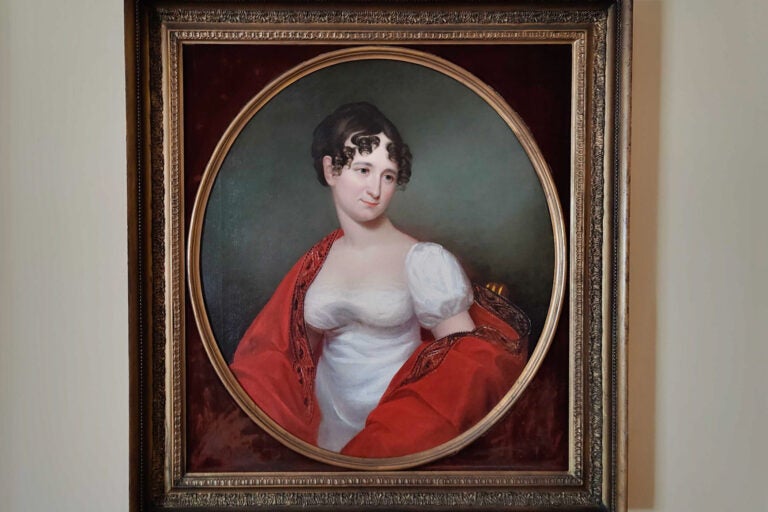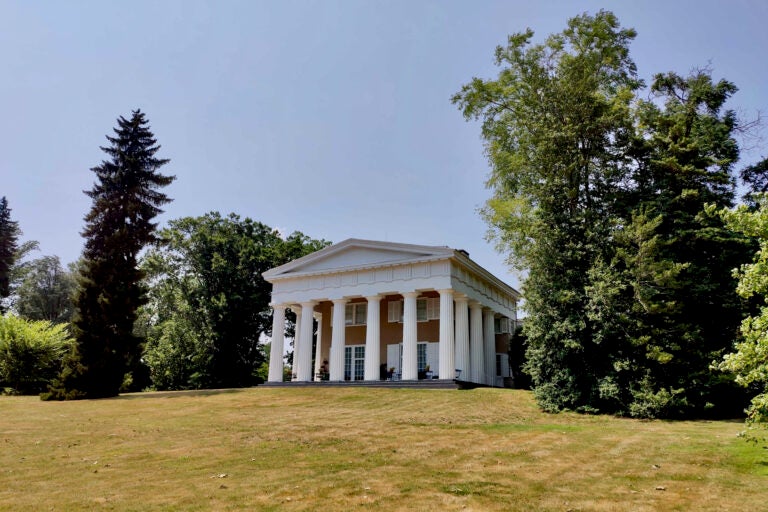From ‘oops!’ to opportunity: Philly’s Seaport Museum gives historic painting to Andalusia estate
Twenty years ago, the maritime museum accidentally bought an 1815 portrait. Her story can now be told at the historic Biddle family estate.

Andalusia executive director John Vick plans to use the 1815 portrait of Adèle Sigoigne to tell more stories about the women associated with the historic Biddle family estate. (Peter Crimmins/WHYY)
From Philly and the Pa. suburbs to South Jersey and Delaware, what would you like WHYY News to cover? Let us know!
Ending a case of mistaken identity, the Independence Seaport Museum has signed over ownership of its portrait of an early 19th century upper-class young woman to the historic Andalusia estate in Bensalem.
The fairly large painting from 1815 depicts Adèle Sigoigne, of whom little is known. The Seaport Museum bought the painting at auction almost 20 years ago for $46,000 with a false understanding of it.
CEO Peter Seibert, who was not with the museum in 2006 and not involved in the purchase, said the museum at the time believed Adèle was an urchin from Haiti discovered on the Delaware River docks in Philadelphia, ultimately adopted by a prominent Philadelphia family. He said there are some unconfirmed historic records that suggest such a thing might have occurred.
“That’s a maritime story, for sure,” Seibert said. “That’s why we had it.”
Turns out, that’s not true. Once museum conservators started cleaning and researching the painting, the story fell apart.
Sigoigne was from a wealthy family in what was then Saint-Domingue, a French Caribbean colony that became Haiti. The family risked becoming targeted by the Haitian Revolution of 1791, so Adèle fled the region with her mother, Aimee Sigoigne.
Mother and daughter arrived in Philadelphia where Aimee founded a finishing school for young women, which attracted clientele from the city’s wealthiest families. Somehow – it’s not clear how – her daughter Adèle befriended Jane Craig, who would later marry into the Biddles, one of Philadelphia’s most historically prominent families.
The Seaport Museum never put the painting on display because it had nothing to do with Philadelphia’s maritime history.
“It’s an ‘oops.’ Every Museum has them,” Seibert said. “Throughout my career I’ve had plenty of ‘oops.’ It’s, you know: ‘Oooooh, I got that one wrong!’
Since 2014, the painting has been on long-term loan to Andalusia, the historic house museum that was the Biddle family’s country estate for 185 years, because the portrait of Sigoigne says more about the Biddles than the Delaware River.
The Seaport Museum has now deaccessioned the painting from its collection and permanently transferred ownership to Andalusia.
“It’s a really great gesture of two museums working together,” said John Vick, executive director of Andalusia. “It really belongs here and it’s great that Peter and the board recognized that.”
Vick moved the painting from a display easel in Andalusia’s downstairs library to one of the original 1790s bedrooms on the second floor. Now that the painting officially belongs to Andalusia, Vick said he can invest more time and resources into fleshing out the relationship between Adèle Sigoigne and Jane Biddle.
That relationship could form the foundation of more stories about the women of the Biddle lineage.
The Andalusia estate came into the Biddle family through Jane Craig. Her father, John Craig, was a wealthy merchant who bought and built the property in 1795. The riverside estate was the site of Jane’s wedding to Nicholas Biddle, who would become president of the Second Bank of the United States and a Pennsylvania state senator.
Once Jane and Nicholas Biddle became owners of Andalusia they expanded the building’s footprint and built its dramatic columned porch overlooking the Delaware River, resembling a Greek temple.
Adèle Sigoigne is known to have been one of the few guests at the Biddle wedding. Vick believes she may have been a regular guest at Andalusia when Jane’s father was its owner.
With her good looks and refined poise, Sigoigne became a kind of poster child for her mother’s finishing school. A later portrait by a different artist, Thomas Sully, features her in 1829 dressed in finery with a harp, showing prospective clients what their daughters could become if they attended Sigoigne’s school. It’s now on view at the Huntingdon museum in California.
Jane Biddle commissioned both portraits of Sigiogne, indicating how important a friend she was.
“I would like to imagine what that friendship was like and how that friendship tracks Jane’s life: through her youth, her meeting Nicholas Biddle, marrying, becoming a mother, eventually she is the owner of Andalusia after Nicholas Biddle passes away,” Vick said. “That friendship endures throughout all of this. The painting is a testament to that friendship.”
With the new acquisition, Vick feels freer to dig more deeply into the woman of Andalusia. Jane Craig’s mother Margaret, for example, was largely in charge of completing the original estate after her husband John unexpectedly died during construction.
A later Biddle, Leticia, moved into Andalusia in 1888 after marrying Charles Biddle. She was the first to plant an expansive flower garden on what had been mostly a commercial agricultural property. From Leticia’s first efforts, Andalusia is now recognized as an arboretum, and this year became the only North American property in the Royal Horticultural Partnership of Britain.
“At every generation there’s a really great story about the women who are involved in making Andalusia what it is,” Vick said. “That’s just going to give us great material to explore and present for many years to come.”

Get daily updates from WHYY News!
WHYY is your source for fact-based, in-depth journalism and information. As a nonprofit organization, we rely on financial support from readers like you. Please give today.












